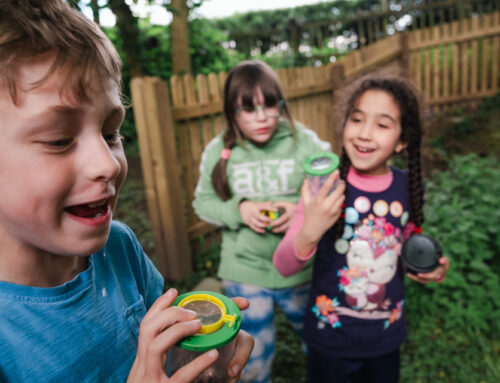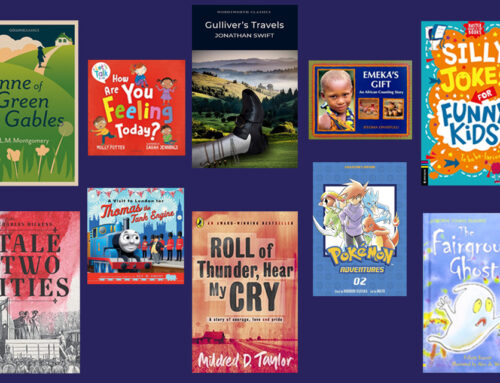From the Archive
This article originally appeared in the Autumn 2013 print edition of Focus on Potential
You are in the supermarket doing your weekly shop. Your child (it almost doesn’t matter what age) spots something they want and when you are in the middle of telling them they can’t have it (because it is too expensive, it’s too close to their birthday/Christmas, you haven’t got an Xbox even though they want the game…) all of a sudden you find they are having the kind of meltdown which makes you wish you were anywhere but pushing along a shopping trolley full of groceries. These kinds of meltdowns could happen to any child in any family; but with a child with high learning potential, the path from here to the checkout queue is paved with issues; their hypersensitivities, their ability to argue, their asynchronous behaviour to mention just a few. So, as we approach the holidays, this article is about helping you to survive those momentous meltdowns and come out of it (hopefully!) smiling.
“My seven-year-old son broke the door off its hinges when he couldn’t get his own way. I just don’t know what to do.” Parent
There is the temptation to jump straight into different scenarios and ask ‘what can we do when Y happens?’ At this time of year, common ones raised on our Information and Advice Line include:
- children’s meltdowns at home following a frustrating day at school
- the buildup of issues when they have started something new (e.g. school or new clubs)
- tiredness at the end of term
- being overwhelmed by activities/the festive season/celebrations
Despite this temptation, I want to take a step back and look in this article at:
- the characteristics of the ‘explosive child’
- some of the potential triggers for meltdowns
- what can be done to contain or reduce a meltdown
- developing a practical action plan for your family
I hope that all of this will help you to come up with an action plan for your family during the holiday season which will put you on the right track in the New Year.
The characteristics of the ‘explosive child’
As you know, children and young people with high learning potential come in all shapes and sizes. However, those children who are more susceptible to having meltdowns are likely to have one or more of the following characteristics:
- Inflexibilities in their behaviour or way of thinking
- Difficulties in managing and controlling their emotions
- Poor working memory and/or processing speeds and the ability to shift gear from one situation to another
- Low frustration thresholds
- Low tolerance for frustration (i.e. they become frustrated at being frustrated and then become overwhelmed)
- See everything in ‘black and white’ and find it difficult to compromise
- Have a fixed view about themselves and find it difficult to accept anything different (e.g. we get many perfectionists in this category)
- Difficulties in thinking through ways of resolving a situation especially when it is new or when they are pushed into a corner
- Sensitive with extremes of emotion
- Need to be in control and find it difficult when they are not in control of the situation
- Forget how to stay calm and in control when they experience something new or outside of their control
- Forget to think through or choose to disregard the consequences of their actions or even the sanctions which they have learnt come as a result of their behaviour. We have seen this, for example, when a child’s strong sense of justice or fairness overrides their fear and they ‘hit out’ at home or school following an incident
- Argumentative particularly when they believe they are right and would prefer to argue even when parents are reasonable or try to discuss the situation
- Difficulties in ‘executive functioning’ skills such as organisational skills or ability to shift from one subject to another.
Put more simply, these children are going down one path and, for whatever reason, are being asked to move to another situation and the problems that this causes forces them into meltdown.
Parents often ask questions like, is all this the result of ‘bad parenting’; is it our fault that our children are going into meltdown; should we be firmer with them; are we too firm? As the list above shows, we might be responsible for our children’s genes but if they are hardwired like this, we need to teach them how to cope with who they are and to manage the resulting behaviour positively and proactively. What can sometimes be ‘our fault’ (often for good reasons) is how we teach them to deal with their characteristics and the messages we give out to them when they are learning how to cope.
Some of the potential triggers for meltdowns
You will know the triggers for your child which cause them to go into meltdown (just as they will know, I hasten to add, just which buttons to press to get you to respond in the way they want!). Common ones which you may recognise include:
- they don’t get/achieve what they want
- they are not able to do what they want
- they cannot regulate their external environment (i.e. they are not in control e.g. at school or they are overwhelmed by the way their ‘external’ environment is structured e.g. going to bed; they need more adult intervention; more physical intervention or even more sensory intervention (e.g. hugs))
- they cannot regulate their ‘internal’ environment (they are too hungry, too cold, too excited, too tired, too overwhelmed, too frustrated).
All of these situations may be made worse by your child’s asynchrony whereby they can have extreme or overwhelming feelings but cannot verbalise them and it becomes easier to hit out than to try and explain these emotions or their cause.
Even if you think you know what causes your child to go into meltdown, it is often useful to keep a diary of their behaviour over, say, a month, recording things like:
- what they are like just before an incident
- how they cope with the incident
- how they ‘come down’ from the incident (e.g. are they full of remorse, do they become very negative or do they not recognise what they have done at all)
“ When my child has calmed down after a meltdown he says he is a bad child and I can’t love him at all because he is so badly behaved. It is very upsetting.” Parent
This will help you develop your action plan for what to do about the meltdown in future. If your child is at school, nursery or takes part in any other activity where they have regular meltdowns, it might be good to get them to keep some sort of record for you about what happens so you can add it into the future action plan. This will enable you to see whether there is a pattern to the issue and how they best respond to what happens.
What can be done to contain or reduce a meltdown?
Your child’s (and your) response to a potentially explosive situation depends, in a large part, on their and your state of mind at the time. For example, situations where you are both in a relatively positive mood when something happens could be diffused through humour. I’ve even tried saying a word (let’s call it ‘potato’) when one or other of my family ‘steps over the mark’. When we are receptive to this it can work quite easily but in some situations the meltdown has gone beyond the point of no return and such techniques don’t work at all.
Once you have a clear idea about what triggers your child’s meltdowns, what do you do then? For me it starts by thinking about those meltdown situations and putting them or the consequences of them into different categories. I usually divide them into two but I have seen a nice structure which divides the issues into three:
Category A – those things that are so important to you that you will not compromise on them, not ever (this is the important bit). I am not going to tell you what these are as they are different for different families. However, some that parents have suggested to me include not hitting/biting/hurting other members of the family (or anyone else for that matter!), or treating other people with respect; but they could include anything – going to school, doing homework, getting ready on time – the list is endless.
Category B – those things that it would be useful for your child not to have a meltdown about and which, if they are in the right mood, they may do rather than explode, but which are not so important that you will cause a meltdown. These then become either an A or a C depending on how your child reacts.
Category C – not important – in which case, once you have considered these you stop worrying about them or forcing the issue. A classic example of this is your child keeping their bedroom tidy. If you can shut the door on their mess then it becomes their problem when they can’t find their clothes (under the pile) or their homework. Or perhaps that is just at my house!
What then do you do?
Well, you ‘don’t sweat the small stuff’ with your Category C’s; you judge the Category B’s on your child’s mood and the situation and you focus on the Category A situations (or likely situations).
With your Category A situations, it is really important to be consistent in your approach in dealing with them. Many of our children can negotiate themselves out of any situation in a way which leaves you feeling that you are somehow wrong or unreasonable or a ‘bad parent’ (“because every other parent allows it”).
The key here is consistency. Whatever you do in this situation you always do otherwise it will never work.
The classic example is the supermarket meltdown as I outlined at the beginning of this piece. Your child sees something they want. You tell them they can’t have it. They come up with a good reason (for them anyway!) about why they should have it. It is one of your Category A non-negotiables. Your child starts to shout, scream and stamp their feet, push the shopping trolley over, pull the tins out of your shopping trolley all over the floor (depending on their age). What do you do?
Option A – shout back at the child?
Option B – give in and put the pack of sweets they want in the shopping trolley?
Option C – tell them you will implement your Category A response?
In the cold light of day when you are sitting reading this in your comfortable armchair we know that Option A means that we have failed to control our own temper and, more importantly, we are modelling the very meltdown behaviour we are trying to teach our child NOT to do; Option B means that we have given in and all we have taught our child is that if they scream VERY loudly they will get what they want.
However, if we are honest, most of us have been there with both Option A and Option B in the past; we would be saints if not. However, just when you are cracking under the pressure, think of the little angel on your shoulder whispering do Category A!
So, what is Category A? You need to come up with your responses to the situation and ideally this needs to be discussed, owned and consistent between you and your partner, parents or other relatives. It also needs to be flexible; remember, if you are all in a good mood when it happens you may diffuse it with a word or with humour or even by encouraging your child to implement some of the techniques you have worked on with them (see below). Let’s assume he or she is going into a fully blown meltdown you may say something like:
“I do not like the way you are treating me. I am not going to buy the sweets. I love you but I don’t like it when this happens”
Try and say this in a calm voice. If they are carrying on you may say:
“ If you do not stop I am going to do X” X will be the response you have agreed.
Ideally, it would not have a negative impact on the rest of the family as they should not be penalised for your child’s behaviour. However, one of my colleagues (who shall remain nameless!) did say she would leave all their shopping in the aisle of the supermarket and her child would not get the ice cream they wanted for their dessert… and she did!
Eventually your child will know the response you have to each Category A situation and you will be able to move quickly to your response to get them to calm down.
However, the key is consistency, no matter how tired you are or how much you would prefer to settle for ‘an easy life’ (we all do that sometimes!). For example, I have a very good friend (with a very tidy house) who threatened to put all her child’s toys in the dustbin if he didn’t tidy them away after playing. He didn’t, she did and then ignored the meltdown. He never did it again (in her house; although interestingly mine looked like a battleground when he went home after playing there!). Other parents do this with school time where they have a child who refuses to get ready on time. The parent threatens to take him/her to school in their pyjamas and they do! Let us know if you have got through the school gates with your child dressed for bed and what happened next!
Sometimes I think we negotiate with our children too much and whilst it looks like we are negotiating with adults, they are still children and need to be given consistent boundaries where they know what will happen if they break the ‘rules’.
That is where the situation occurs and you have your action plan ready to put in place. What about the child him/herself, what can you do to help them with these meltdowns?
Lots of parents have systems that they put in place with their child to help them control or respond more positively to a meltdown situation. Examples include:
- encouraging the child to walk away from a potentially explosive situation to calm down
- encouraging the child to think and count to ten before they respond to a situation
- teaching children the skills for stopping any aggressive behaviour (biting, hitting, kicking). Examples include:
- encouraging their child to do something active (some parents take their children to martial arts, encourage them to go into the garden or park with a ball or have a bit of (safe) ‘rough and tumble’)
- scribbling out their aggression with a crayon on a piece of paper
- doing some other exercise e.g. walking the dog
Ultimately, it is important for the child to recognise and manage their feelings and to understand what causes them to have meltdowns. This is easier said than done, especially of your child is quite young or if you have ‘lost them’ during a meltdown situation or they believe they are right even after an explosive episode.
As a first step towards this, parents need to encourage their child to talk about their feelings and ideally help them problem solve their own response to what is happening. Ideally this would be done at a time when the child is in a good mood (and definitely not in the meltdown phase!) and willing to talk. Parents often say that when they are driving is a good opportunity for the child to talk because they are in the back seat of the car.
Parents will know that I am a big fan of the book ‘How to talk so kids will listen and listen so kids will talk’ by Adele Faber and Elaine Mazlish and I would definitely recommend it (there is even a version for teenagers!). What you need to do is to listen to your child rather than solve their problems for them (if they don’t know or can’t verbalise what is happening to them try getting them to draw a picture of their feelings). To do this, it is useful to tell them that such anger is often a normal response to things that are going on. Also, you need to acknowledge their feelings and what has happened to them even if it is negative. For example, if they have just hit you, you might say something like (in a calm voice):
“I understand that you are very unhappy/angry. When you hit me it hurts and I don’t like it. I love you very much but I do not want you to hit me as it makes me cry” (or words to that effect). Seeing the consequences of their actions like this may bring it home to them that they have hurt those they love.
When they are ready, you then need to help them to develop their own action plan for dealing with their meltdowns. If it is their action plan they are much more likely to own it and follow through with it.
Other things which may help:
- modelling the behaviour you want them to see (for example, shouting when you are teaching them to be calm is definitely not helpful)
- telling them about how you dealt with a similar situation
- giving your child a limited number of choices which can make them feel more in control and can help in certain situations, for example:
“ I know you are angry as it looks really hard to put your coat on. Do you want me to put it on for you or do you want to put it on yourself?”
- getting them to develop a plan, for example:
“I want you to go to school and you want to play with your toys. What can we do that makes us both happy?” speaking in a clear voice using short phrases which are (ideally positive) “Put your coat on”
- reading books about how characters deal with the issue
- write stories together about how a character coped with their anger/feelings
Tips for a meltdown where they are not listening at all
In these situations, it is important to react quickly or someone may get hurt. In such situations, you may need to come up with an emergency plan including things like:
- ensuring your child and everyone else is safe
- isolating your child
- stopping talking to you child unless your words have a soothing effect
- using calming strategies you know work on your child e.g. give them something to eat or drink, hug them, rock them in your arms. This can even be done with teenagers.
Developing a practical action plan for your family
This is a longer article than I intended and I am conscious that I have only just scratched the surface of the issues connected with meltdowns. However, I hope that it gives you some ideas and pointers for how you can help to manage the momentous meltdowns of your child. Obviously, your response will need to be amended for the age of your child and the circumstances they are in. However, the principles outlined should be relevant, at least in part, for many situations. If I were to try and summarise an outline action plan for you it would be:
- Identify what is causing your child’s meltdowns
- Teach your child how to manage their behaviour in response to a meltdown
- Ensure that all the family model the behaviour you want to see
- Divide your categories of meltdown into A B or C. Ignore Category C and make sure you have responses for the Category A issues
- Listen to your child and help them come up with a solution to the issues they face. Don’t forget meltdowns don’t come out of nowhere; often there is something which lies behind it (e.g. not being in control)
- Amend your behaviour to the situation, using humour, giving a choice or letting them problem solve for themselves if appropriate
- For emergency situations ensure they are safe and use calming techniques
- Do not blame or hold grudges for what happens and do not make it personal to the child (‘it ‘hurt me’ not ‘you hurt me’)
- Make sure you have a consistent approach within your own family and ideally with the school, nursery or elsewhere
- Don’t bury your head in the sand. Remember that you are the parent/s and you need to be in control but be firm, consistent and fair.
Remember, you are not on your own. Managing momentous meltdowns is a common issue and one which is not easy to address in the short term. Good luck!
This article was written by former Potential Plus UK Chief Executive, Denise Yates






